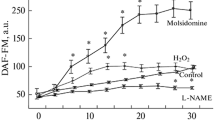Summary
Changes in extracellular pH (pH o ) in human red cell suspensions were monitored in a stopped-flow rapid reaction apparatus. A 20% suspension of washed human RBC in saline at pH 7 containing NaHCO3 and extracellular carbonic anhydrase was mixed with an equal volume of buffered saline solution at pH 6.7. Sodium salicylate, when present, was added to both the erythrocyte suspension and the buffer solution. The effects of salicylate in the therapeutic to toxic concentration range on HCO −3 /Cl− exchange were studied at 37°C. HCO −3 /Cl− exchange flux was estimated using the extracellular buffer capacity and the difference betweendpH o /dt using a control RBC suspension and that using a suspension of RBC whose anion exchange pathway was markedly inhibited. The results show that salicylate competitively decreases the rate of HCO −3 /Cl− exchange, with inhibition increasing as salicylate concentration increases.K I is ∼2.4mm. At a salicylate concentration of 10mm, HCO −3 /Cl− exchange under the conditions of our experiments was inhibited by more than 70%. These findings are consistent with the possibility that CO2 transfer in capillary bedsin vivo may be diminished in the presence of salicylate due to slowing of red cell HCO −3 /Cl− exchange.
Similar content being viewed by others
References
Burgin, H., Schatzmann, H.T. 1979. The relation between net calcium, alkali cation and chloride movements in red cells exposed to salicylate.J. Physiol. (London) 287:15–32
Cabantchik, Z.I., Rothstein, A. 1972. The nature of the membrane sites controlling anion permeability of human red blood cells as determined by studies with disulfonic stilbene derivatives.J. Membrane Biol. 10:311–330
Chow, E.I., Crandall, E.D., Forster, R.E. 1976. Kinetics of bicarbonate-chloride exchange across the red blood cell membrane.J. Gen. Physiol. 43:582–590
Crandall, E.D., Bidani, A. 1981. Effects of RBC HCO −3 /Cl− exchange kinetics on lung CO2 exchange: Theory.J. Appl. Physiol. 50:265–271
Crandall, E.D., Klocke, R.A., Forster, R.E. 1971. Hydroxyl ion movements across the human erythrocyte membrane.J. Gen. Physiol. 57:664–683
Crandall, E.D., Mathew, S.J., Fleischer, R.S., Winter, H.I., Bidani, A. 1981. Effects of inhibition of RBC HCO −3 /Cl− exchange on CO2 excretion and downstream pH disequilibrium in isolated rat lungs.J. Clin. Invent. 68:853–862
Dalmark, M., Wieth, J.O. 1972. Temperature dependence of chloride, bromide, iodide, thiocyanate and salicylate transport in human red cells.J. Physiol. (London) 224:583–610
Deuticke, B. 1970. Anion permeability of the red blood cell.Naturwissenschaften 57:172–179
Deuticke, B. 1977. Properties and structural basis of simple diffusion pathways in the erythrocyte membrane.Rev. Physiol. Biochem. Pharmacol. 78:1–98
Hart, F.D. 1976. Rheumatic disorders.In: Drug Treatment. G.S. Avery, editor. pp. 634–652. Lea & Febiger, Philadelphia
Jacobs, M.H., Stewart, D.R. 1942. The role of carbonic anhydrase in certain ionic exchanges involving the erythrocyte.J. Gen. Physiol. 25:539–552
Obaid, A.L., Crandall, E.D. 1979. HCO −3 /Cl− exchange across the human erythrocyte membrane: Effects of pH and temperature.J. Membrane Biol. 50:23–41
Passow, H., Schnell, K.F. 1969. Chemical modifiers of passive ion permeability of the erythrocyte membrane.Experientia 25:460–468
Schnell, K.F. 1972. On the mechanism of inhibition of the sulfate transfer across the human erythrocyte membrane.Biochim. Biophys. Acta 282:265–276
Wieth, J.O. 1970. Effect of some monovalent anions on chloride and sulphate permeability of human red cells.J. Physiol. (London) 207:581–609
Wieth, J.O., Brahm, J. 1978. Salycilats haemmende virkning pa klorid-og-bikarbonat transport i rode blodlegemer.Ugeskr. Laeg. 140:1859–1865
Wieth, J.O., Brahm, J. 1980. Kinetics of bicarbonate exchange in human red cells.In: Membrane Transport in Erythrocytes. U.V. Lassen, H.H. Ussing, and J.O. Wieth, editors. pp. 467–482. Munksgaard, Copenhagen
Wosilait, W.D. 1976. Theoretical analysis of the binding of salicylate by human serum albumin: The relationship between free and bound drug and therapeutic levels.Eur. J. Clin. Pharmacol. 9:285–290
Author information
Authors and Affiliations
Rights and permissions
About this article
Cite this article
Crandall, E.D., Winter, H.I., Schaeffer, J.D. et al. Effects of salicylate on HCO −3 /Cl− exchange across the human erythrocyte membrane. J. Membrain Biol. 65, 139–145 (1982). https://doi.org/10.1007/BF01870477
Received:
Revised:
Issue Date:
DOI: https://doi.org/10.1007/BF01870477




